Physical Address
304 North Cardinal St.
Dorchester Center, MA 02124
A benign tumor composed of modified smooth muscle cells (e.g., glomus cells)
Subclassified into three groups based on the proportions of glomus cells, blood vessels, and (perivascular) smooth muscle cells into:
Classical or solid glomus tumor
Predominance of glomus cells
Blood vessels small and nondistinctive
Glomangioma
Blood vessels are prominent and dilated
Represents the most common variant
Glomangiomyoma
Prominent smooth muscle component
The rarest subtype
Pattern of presentation/occurrence
Solitary or multiple (localized, plaquelike, disseminated) lesions
Sporadically or in the familial setting with autosomal-dominant inheritance pattern
Acquired or congenital
Multiple tumors generally correspond to glomangioma on histology
Equal gender distribution for solitary and multiple lesions
Solitary lesions
Wide age distribution
Predominance in age groups between 20 and 40 years
Multiple lesions (in about 10%)
Age of onset typically 10 to 15 years earlier than for solitary lesions
Tend to occur predominantly in children
Congenital occurrence also reported
About two-thirds of the lesions develop by the age of 20 years
Presentation in adults uncommon
Nonhereditary or hereditary with autosomal-dominant inheritance with incomplete penetrance and variable expressivity
Familial glomangiomas, also designated familial glomovenous malformations, have been found to be associated with mutations in the glomulin gene located on chromosome 1p21-22
Represents less than 2% of soft tissue tumors
The triad of symptoms, described by Masson in 1924
Excruciating pain out of proportion to the size of the lesion
Localized tenderness, reflected by positive Love sign (tenderness to a pinpoint spot with the end of the pencil)
Temperature sensitivity, especially for cold, or changes in temperature, precipitating pain
Solitary lesions
By far predominate (about 90%)
Slowly growing papule or nodule with bluish discoloration, plaquelike presentation also reported
Less than 1 cm in diameter
Predilection for subungual areas of the finger, followed by palm, wrist, forearm, and foot
Diverse extracutaneous sites, including gastrointestinal tract (esophagus, stomach, small bowel, colon), respiratory tract (trachea, lungs), mediastinum, bones, and peripheral nerves
Multiple lesions
Small papules or nodules measuring usually from 0.1 to 0.3 cm and generally not exceeding 3 cm in diameter
Plaquelike variant characterized by numerous reddish-blue papules grouped in a single or multiple plaques, and is frequently congenital
Average number of lesions from 10 to 20
Less often painful than solitary forms
Lesions can become painful during the menstrual period or pregnancy, suggesting sensitivity to estrogens
Association with diverse conditions has been reported, including multiple endocrine neoplasia (MEN) II syndrome, neurofibromatosis type I, arteriovenous (AV) fistulae, and brachydactyly
Predilection for upper limbs
Benign clinical course
Complete surgical excision generally curative
Recurrences after incomplete/marginal excision from 5% to 50% and tend to be more common at subungual sites
Treatment in multiple lesions is directed toward symptomatic ones
Other treatment options include laser therapy and sclerotherapy
Classical or solid glomus tumor
Well-demarcated, unencapsulated proliferation in the dermis/subcutis
Nests and/or solid sheets of glomus cells
Round to oval, centrally located, uniform nuclei
Pale eosinophilic cytoplasm with well-defined borders
Mitoses absent or rare
Atypical mitoses absent
Rare variants consist of cells with epithelioid morphology
Vascular component inconspicuous, usually in the form of thin-walled and frequently branching capillaries lined by flat endothelial cells
Glomangioma
Less circumscribed, occasionally with infiltrative growth in the dermis/subcutis
Vascular component prominent
Dilated and congested vascular spaces, reminiscent of cavernous hemangioma, lined by a single layer of bland endothelial cells
Thrombosis and organization of thrombi with formation of phleboliths not uncommon
Glomus cells surround vascular spaces in a single or double layer, multilayering less common
Glomangiomyoma
Smooth muscle cell component in addition to solid proliferation of glomus cells, the amount of the former component varies and is usually prominent
Spindle cells arranged in bundles, fascicles, or display more irregular growth pattern
Gradual transition from solid proliferation of glomus cells toward elongated smooth muscle cells (e.g., transitional zone) usually seen
Infiltrative glomus tumor
Designation for glomus tumors with banal cytology, but infiltrative growth pattern
Usually occurs in deep soft tissues
Additional histological features
Stroma
Myxoid/collagenized
Can contain scattered nerves
Areas of calcification or bone formation uncommon
Overlying epidermis generally unremarkable
Smooth muscle actin, muscle specific actin positive
Variable CD34 positivity
Desmin usually negative, focal positivity occasionally reported
MIR143 - NOTCH fusions are harbored in both benign and malignant glomus tumors, but not other myopericytic tumors; NOTCH 1 (9q34), NOTCH2 (1p31), and less commonly NOTCH3 (19p13.12) can be involved
Eccrine spiradenoma
Nodular hidradenoma
Vascular tumors
Vascular malformations
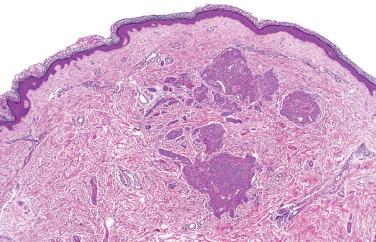
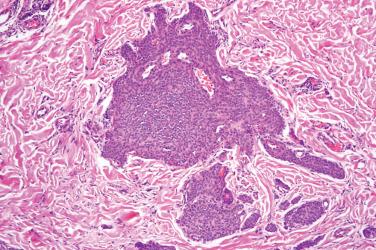
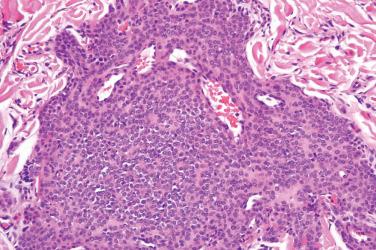
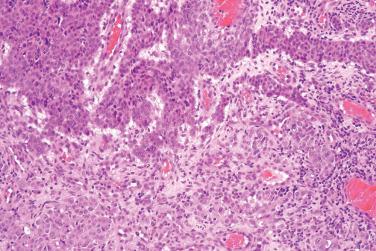
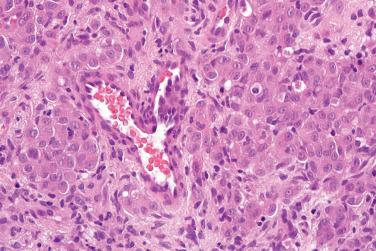
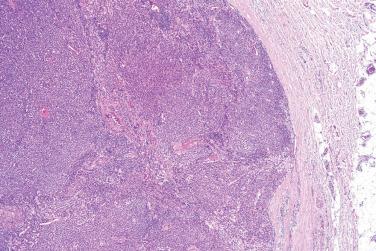

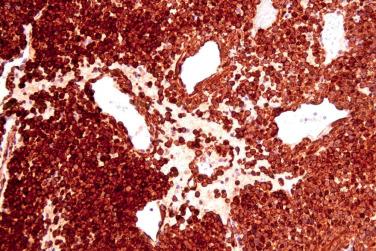
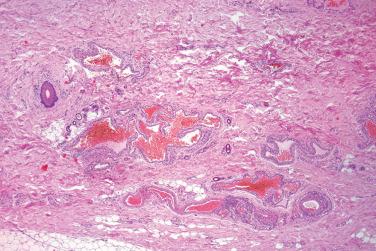
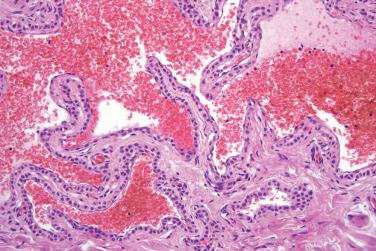
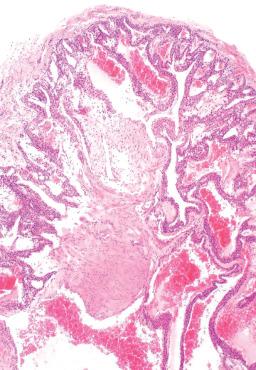
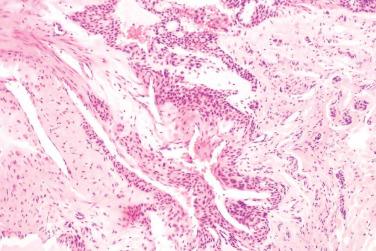
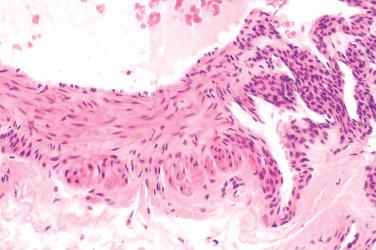
A very pale histological variant of glomus tumor displaying areas of cytological atypia and nuclear pleomorphism, not associated with malignancy
Nuclear atypia likely degenerative phenomenon and/or related to cellular senescence, with DNA methylation possibly involved in the pathogenesis of the symplastic change
Female predominance (F : M = 3 : 1)
Wide age distribution (from 16 to 83 years), most common in the fifth decade
Slowly growing, tender or painful nodule
Pain can be triggered by cold exposure
Subungual lesions can be associated with nail deformities
Size less than 1 cm in diameter
Predilection for fingers, particularly subungual site
Complete local excision generally curative
Recurrences rare (up to 13%), usually after incomplete/marginal excision, less likely due to synchronous satellite lesions
Nonencapsulated, well-demarcated proliferation in the dermis, with possible extension into the subcutis
Areas of classical glomus tumor usually present at the periphery of the proliferation (see earlier)
Defining histological feature is polygonal tumor cells with pronounced cytological atypia (e.g., symplastic change), but lacking other features of malignancy
Nuclei large and pleomorphic, frequently hyperlobated and bizarre shaped with hyperchromasia, intranuclear cytoplasmic pseudoinclusions, coarse chromatin, and irregular nuclear membrane
Mitotic activity generally absent
Necrosis absent
Pale eosinophilic cytoplasm with indistinct cellular borders
Smooth muscle actin and CD34 positive
Desmin, S100 protein, cytokeratin, CD31, and factor XIIIa negative
Ki-67/MIB-1 negative or very low (less than 1% of the tumor cells)
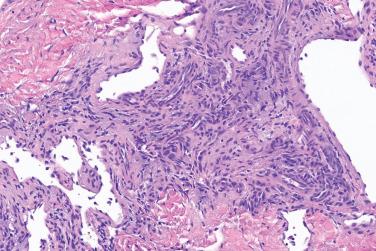
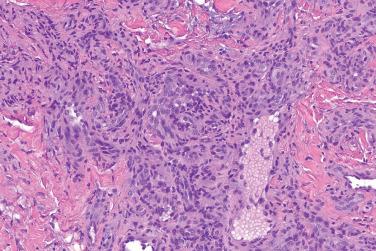
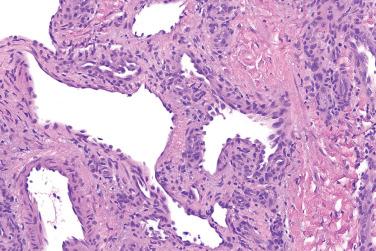
Glomangiomatosis is defined as angiomatosis associated with a prominent glomus cell component
Most common in the third decade of life
Slightly more common in females
Very rare, with fewer than 20 cases reported
Become a Clinical Tree membership for Full access and enjoy Unlimited articles
If you are a member. Log in here